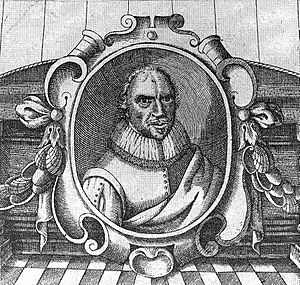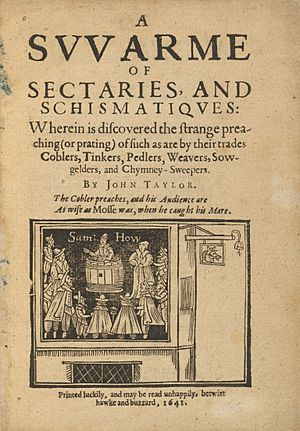John Taylor (poet) facts for kids
Quick facts for kids
John Taylor
|
|
|---|---|

John Taylor: a portrait engraved by Thomas Cockson, included in Taylor's 1630 poetry anthology
|
|
| Born | 24 August 1578 |
| Died | December 1653 (aged 75) |
| Occupation | Poet |
John Taylor (born August 24, 1578 – died December 1653) was an English poet. He was known as "The Water Poet" because of his job.
Contents
John Taylor: The Water Poet
John Taylor was born in Gloucester, England, on August 24, 1578. He went to elementary and grammar school there. However, he did not finish his formal education. He found Latin studies difficult.
Early Life and Becoming a Waterman
In the early 1590s, John Taylor moved to south London. He began training to become a waterman. This job involved rowing boats to carry people across the River Thames. At that time, London Bridge was the only way to cross the river by land. Watermen were very important for travel in London.
After his training, he served in the navy. In 1596, he joined the fleet of the Earl of Essex. He took part in the Capture of Cádiz in Spain that year. He also sailed to Flores in the Azores in 1597.
Life on the River Thames
John Taylor spent most of his life as a Thames waterman. He was a member of the boatmen's guild. This group ferried passengers across the river. His job helped him meet many people. He carried actors and playwrights to the theatres on the Bankside.
In 1620, Taylor said that almost 20,000 men worked as watermen. This included their families and helpers. By 1641, he thought there were over 40,000 people in the watermen's company. He became a leader in the guild. He wrote about the watermen's problems in 1641–42. They wanted to make the leadership of their company fairer. He wrote about these events in his pamphlets.
Challenges for Watermen
Taylor also wrote about problems between watermen and theatre companies. In 1612, theatres moved from the south bank to the north bank of the Thames. This meant fewer people needed boat rides. This greatly reduced the watermen's income. Even though Taylor worked for the king, he could not stop the move.
He also wrote about the rise of horse-drawn carriages. These new "coaches" took away much of the watermen's business. People started traveling by land instead of by river. In his 1622 work An Arrant Thief, he wrote:
All sorts of men, work all the means they can,
To make a Thief of every waterman :
And as it were in one consent they join,
To trot by land i' th' dirt, and save their coin.
Carroaches, coaches, jades, and Flanders mares,
Do rob us of our shares, our wares, our fares :
Against the ground, we stand and knock our heels,
Whilst all our profit runs away on wheels ;
And, whosoever but observes and notes,
The great increase of coaches and of boats,
Shall find their number more than e'er they were,
By half and more, within these thirty years.
Then watermen at sea had service still,
And those that staid at home had work at will :
Then upstart Hell-cart-coaches were to seek,
A man could scarce see twenty in a week ;
But now I think a man may daily see,
More than the wherrys on the Thames can be.
When Queen Elizabeth came to the crown,
A coach in England then was scarcely known,
Then 'twas as rare to see one, as to spy
A Tradesman that had never told a lie.
Amazing Journeys and Writings
John Taylor was a very active poet. He published over 150 works during his life. Many of his writings were collected in All the Workes of John Taylor the Water Poet (1630). His work was not fancy, but he was good at observing people. Historians still study his writings to learn about the 17th century. For example, his 1621 work Taylor's Motto listed popular card games of the time.
He became famous for his unusual journeys. One time, he traveled from London to Queenborough in a paper boat. He used two stockfish (dried fish) as oars! He wrote about this trip in "The Praise of Hemp-Seed". This journey was even re-enacted in 2006.
In 1618, he traveled to Scotland without any money. He wrote about this trip in his book Pennyless Pilgrimage. (Ben Jonson also walked to Scotland that same year.) Taylor is also known for writing one of the first palindromes. In 1614, he wrote: "Lewd did I live, & evil I did dwel". A palindrome reads the same forwards and backwards. He also wrote a poem about Thomas Parr. This man supposedly lived to be 152 years old. Taylor also created his own language called Barmoodan.
Many of Taylor's books were published by subscription. This means he would announce a book idea. Then, people would pay him in advance. He would write and print the book once he had enough money from these payments. He had over 1,600 people subscribe to his book The Pennylesse Pilgrimage. This book was about his journey from London to Scotland without money.
Later Life and Passing
John Taylor died in London in December 1653. He was 75 years old. He was buried on December 5 at the church of St Martin-in-the-Fields. His wife, Alice, passed away in January 1658.


